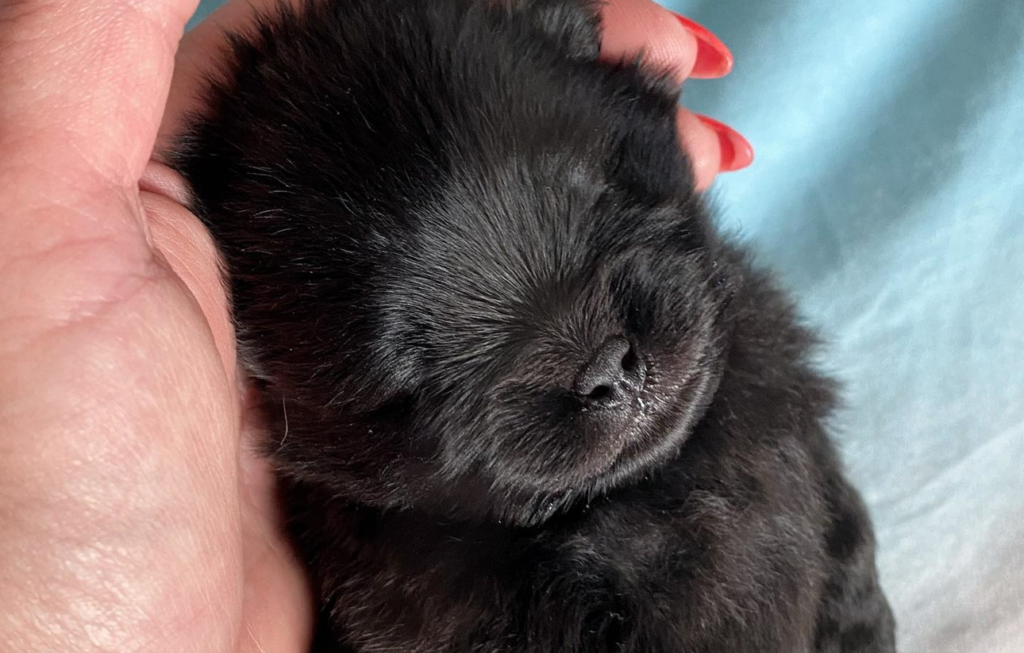People have been discriminating against black Pomeranians because of their color. Because most people believed black brings back luck at that time, they have been abused and abandoned.
But now, black Pomeranians have become the second most popular and demanded Pomeranian color after white. It is likely because more people are realizing that there’s no such thing as black bringing bad luck – every animal is special in its own way!
A show-quality purebred Black Pomeranian puppy can cost anywhere between $600 and $1,500. Puppies purchased to be house pets will generally cheaper, costing around $350 to $900.
General Appearance of Black Pomeranians
Black Pomeranians have a sleek and shiny coat that is black in color. And they’re only different from regular Pomeranians in the coat color.
In fact, black dogs of all breeds are often overlooked in shelters simply because of their color.
When surrounded by dark fur, their facial expressions are harder for potential adopters to read.
For example, black Pomeranians may not appear friendly and happy when first met because their fur can hide their expressions.

Breeding Black Pomeranians

Choosing a solid black mate is important when breeding pure black Pomeranians. It’s also helpful to learn about their genetics and what kind of coat they are likely to produce before committing.
Once you’ve found a suitable mate, it’s time to get down to business! Mating can be an exciting but nerve-wracking experience – make sure both parties are comfortable and relaxed before proceeding.
Pregnancy and whelping preparation take up most of the nine weeks between mating and birth; keep an eye on your bitch for any signs of distress or illness, and prepare everything you’ll need for her big day (and beyond).
Finally, it’s time for the puppies to make their appearance! Whelping can be a challenging experience, but with proper preparation and care, both mother and puppies should do just fine.
“Black Dog Syndrome” and Bad Luck

In many cultures, black has been associated with bad luck, darkness, and death. And that’s why some people still consider black color pets as bad luck. In reality, there is no such thing as proved through science.
“Black Dog Syndrome” is a term used to describe this negative mindset toward black dogs. But, it is always up to you to decide whether you believe the myth or not.
Therefore, a Black Pomeranian only brings bad luck if you believe so. Otherwise, you’ll be fine.
Color Changes with Black Coats

In some cases, Pomeranians with black coats change their color over time. It’s believed that it happens when the coat is exposed to various lighting conditions, temperatures, and chemicals. Other than that, some cases have been reported because of some medicines.
But what is the science behind these color changes? I researched deeply into this and found out that it happens because of the coat’s pigment cells. Melanin is what gives hair its color. When the pigment cells start producing less melanin than the required amount, a black Pomeranian’s coat changes to another color.
Best Names for Black Pomeranians

It’s important to give your black Pomeranian a name that reflects their unique personality and appearance.
So, I made a list of the best names that fit black Pomeranian to make the process easy.
Male Black Pomeranian Names
- Blackie
- Shadow
- Smokey
- Poppy
- Olive
- Nova
- Coal
- Jordan
Female Black Pomeranian Names
- Ashley
- Luna
- Onyx
- Bonnie
- Quinn
- Pepper
- Maude
- Mocha
How to Identify a Black Pomeranian

The best way to identify a black Pomeranian is by its coat.
First, take a look at the dog’s coat. Black Pomeranians have a black double coat, but there won’t be any color mixes in the back or top. They may have some white markings on their chest and toes.
Next, observe the dog’s eyes. Black Pomeranians typically have dark brown or black eyes. Check out the dog’s nose. Black Pomeranians usually have a black nose with no other markings on it.
How to Take Care of a Black Pomeranian Coat

If you’ve got a black Pomeranian, then you know that taking care of their coat is important to keep them looking their best. Here are some tips on how to take care of your Pom’s coat.
Brush regularly
You should brush your Pom’s coat at least once a week to prevent mats and tangles from forming. A good quality bristle brush or comb will work well for this purpose. Be gentle while brushing so as not to hurt your dog’s skin.
Bathe monthly
Bathing your Pom too often can strip the natural oils from their fur, making it dry and brittle. Once a month should suffice unless they get particularly dirty (Eg: playing in the mud).
Always use a shampoo specifically designed for dogs when bathing them. Human shampoo can cause irritation and dryness.
Keep them well-groomed
In addition to regular brushing and bathing, you’ll also need to trim your Pom’s nails, brush their teeth and clean their ears on monthly basis. It will help keep them healthy and looking their best.
Protect them from the sun
Black Pomeranians are especially susceptible to sunburn due to their dark fur coat. When taking your Pom outside, be sure to apply sunscreen (SPF 30 or higher) liberally, paying special attention to areas like the nose, tips of the ears, and underbelly where there is little fur coverage.







